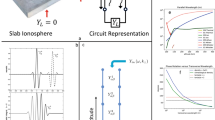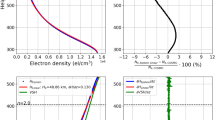Abstract
THE rate of fading of Earth satellite signals caused by the ionospheric Faraday effect was used by British workers1,2 to make estimates of the integrated electron content of the ionosphere up to the height of the satellite. The values obtained were, however, apparently too high. A possible reason for this is failure to take into account the radial velocity component of the satellite which, for certain portions of the orbit, can cause an appreciable contribution to the fading.
This is a preview of subscription content, access via your institution
Access options
Subscribe to this journal
Receive 51 print issues and online access
199,00 € per year
only 3,90 € per issue
Buy this article
- Purchase on SpringerLink
- Instant access to full article PDF
Prices may be subject to local taxes which are calculated during checkout
Similar content being viewed by others
References
Staff of the Mullard Radio Observatory, Nature, 180, 879 (1957).
Burgess, B., Proc. Inst. Elect. Eng., Part B, 105, 112 (1958).
Author information
Authors and Affiliations
Rights and permissions
About this article
Cite this article
DANIELS, F., BAUER, S. Faraday Fading of Earth Satellite Signals. Nature 182, 599 (1958). https://doi.org/10.1038/182599a0
Issue Date:
DOI: https://doi.org/10.1038/182599a0



